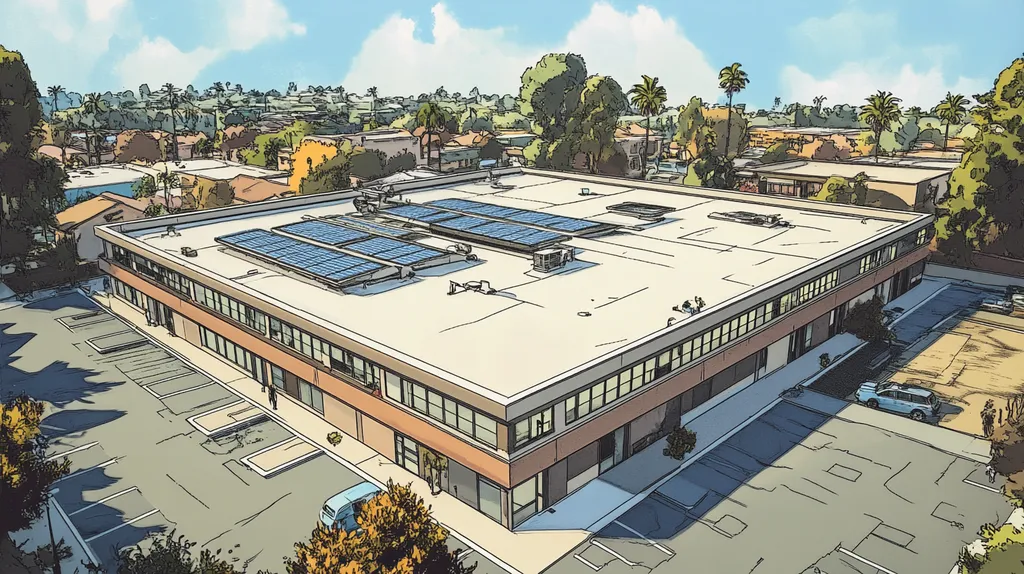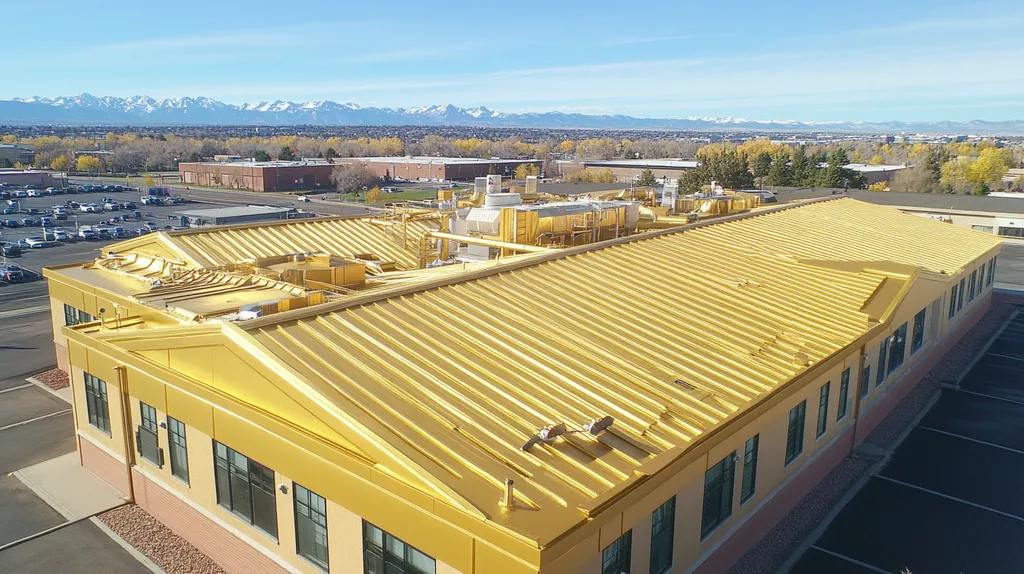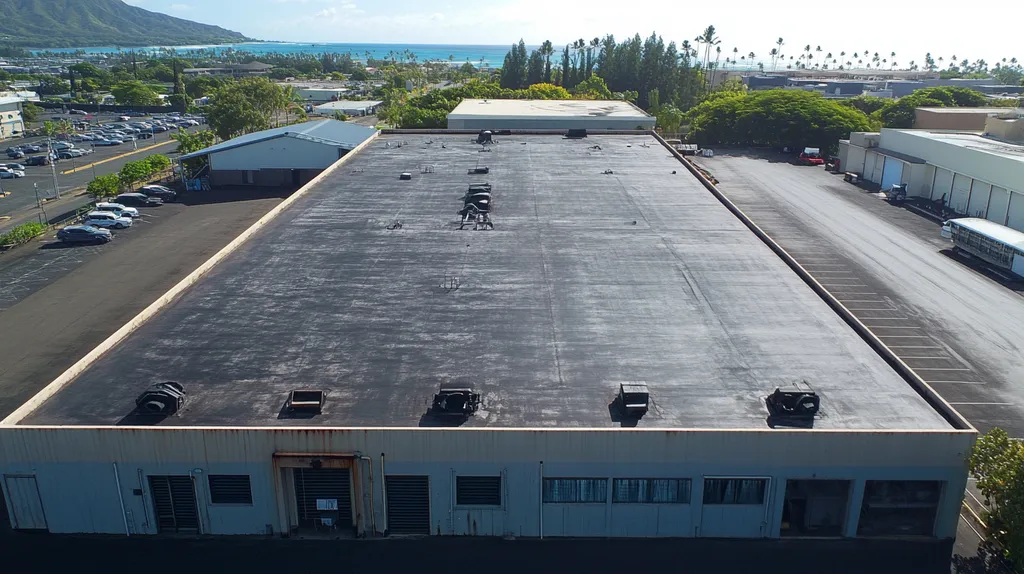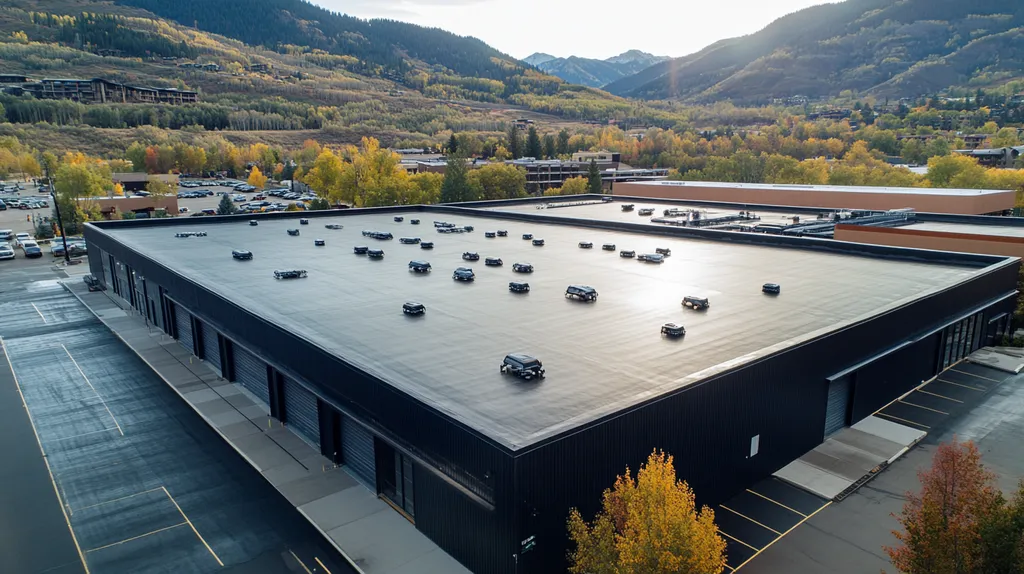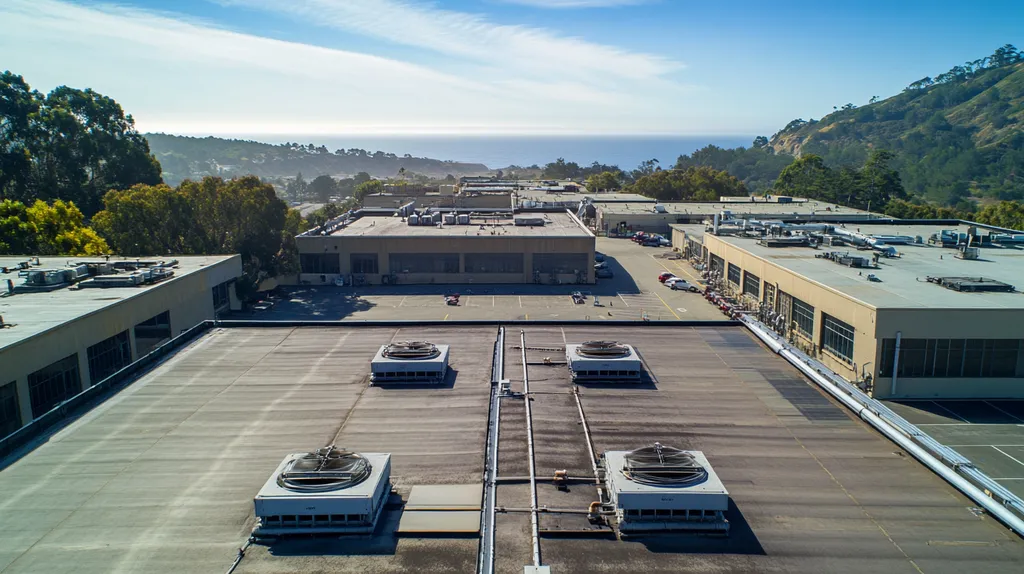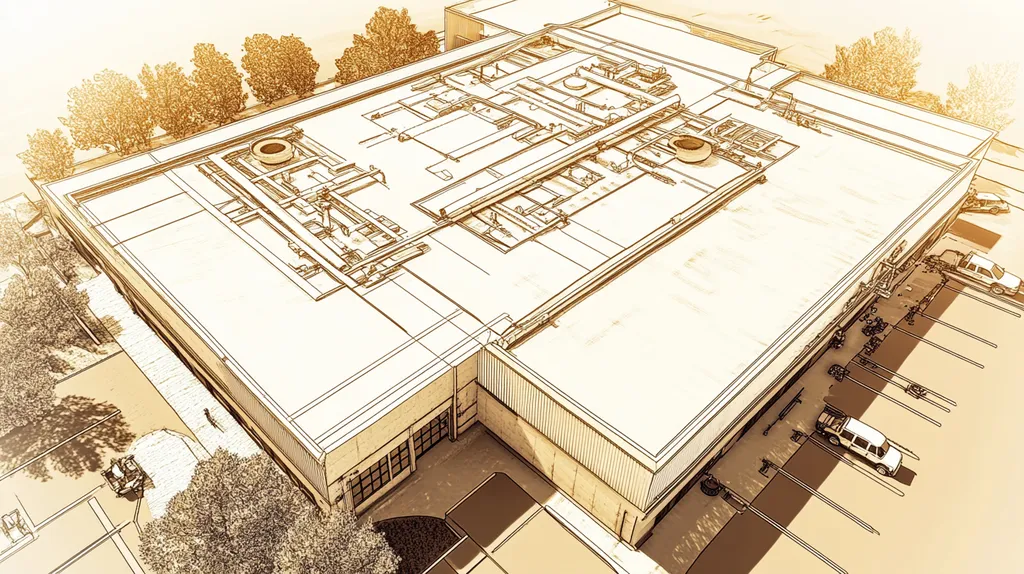The industrial roofing sector loses an estimated $3.3 billion annually to ineffective coating maintenance practices, despite record investments in energy-efficient technologies. These losses stem from a fundamental disconnect between coating application and long-term maintenance requirements.
While energy-efficient coatings promise substantial savings through reduced cooling costs, emerging data reveals concerning patterns of premature failure and escalating maintenance expenses.
This analysis examines the systemic issues driving maintenance costs higher, challenges conventional wisdom about coating effectiveness, and presents evidence-based solutions for protecting industrial roofing investments.
SECTION 1: CURRENT PRACTICES
The landscape of industrial roofing has undergone a dramatic transformation with the widespread adoption of energy-efficient coatings. Today, these coatings represent a multi-billion dollar segment of the commercial roofing industry, promising significant energy savings and improved building performance. Yet beneath this promising exterior lies a complex web of maintenance challenges that many facility managers discover too late. Understanding the true impact of these coatings on long-term maintenance costs has become crucial for property owners making roofing decisions.
Prevalence of Energy-Efficient Coatings
Energy-efficient roof coatings have emerged as a standard solution in commercial and industrial properties, with adoption rates doubling over the past decade. These reflective coatings can reduce building temperatures by reflecting up to 90% of UV rays, which translates to substantial cooling cost reductions. (source: Henry)
Despite their growing popularity, many facility managers struggle to navigate the vast array of coating options available. The market includes everything from basic acrylic coatings to advanced silicone-based solutions, each with distinct maintenance requirements.
The rush to adopt these technologies has created a concerning trend where long-term maintenance implications are often overlooked in favor of immediate energy savings. This oversight can lead to unexpected costs and premature coating failure.
Standard Application Procedures
The effectiveness of energy-efficient coatings heavily depends on proper application procedures, which require extensive surface preparation and precise environmental conditions. Many coating failures can be traced back to inadequate surface cleaning or application during unsuitable weather conditions.
Temperature, humidity, and substrate condition all play critical roles in coating adhesion. Yet these factors are frequently overlooked in the rush to complete projects, leading to premature coating deterioration.
Quality control during application remains a persistent challenge. Without proper oversight, even minor application errors can create weak points in the coating system, leading to increased maintenance frequency and costs.
The complexity of modern coating systems demands specialized knowledge and equipment. Unfortunately, many contractors lack the necessary expertise, resulting in substandard applications that compromise long-term performance.
Common Maintenance Schedules
Current maintenance practices for energy-efficient coatings typically follow a semi-annual inspection schedule. However, this standardized approach often fails to account for specific environmental conditions and coating types.
The reality of maintenance requirements frequently exceeds initial expectations. While manufacturers may suggest simple cleaning and occasional touch-ups, actual field experience reveals more intensive maintenance needs.
Weather exposure, chemical fallout, and mechanical damage can accelerate coating degradation. These factors necessitate more frequent inspections and repairs than many facility managers anticipate.
The true cost of maintaining energy-efficient coatings becomes apparent only after several years of service. By then, many properties find themselves locked into maintenance cycles that exceed their original budget projections.
SECTION 2: SYSTEMIC ISSUES
The widespread adoption of energy-efficient roof coatings has exposed critical weaknesses in how commercial properties manage their roofing assets. Industry data reveals that 65% of premature coating failures stem from systemic maintenance issues rather than product defects. These failures cascade through organizations, creating a complex web of increased operational costs, compromised building performance, and potential liability exposure.
Inadequate Inspection Protocols
Modern energy-efficient coatings demand rigorous inspection protocols that many facilities struggle to implement. Surface degradation often begins invisibly, with microscopic breaches that standard visual inspections miss entirely.
The complexity of today’s coating systems requires specialized knowledge beyond traditional roofing expertise. Without proper training, maintenance teams frequently overlook early warning signs that could prevent costly failures.
Digital documentation and tracking systems, while essential for modern roof management, remain underutilized. This gap leaves many facilities without the historical data needed to optimize maintenance schedules and predict potential failures.
Temperature fluctuations and weather exposure create unique stress patterns that require systematic monitoring. Yet most inspection protocols fail to account for these dynamic conditions, leading to accelerated coating deterioration.
Hidden Costs of Reactive Maintenance
Reactive maintenance approaches typically cost 3-5 times more than planned interventions. When coating issues escalate into emergency repairs, facilities face not just direct repair costs but also potential production disruptions.
Energy efficiency benefits can quickly evaporate when coating integrity fails. A compromised coating system forces HVAC systems to work harder, leading to increased energy consumption and accelerated equipment wear.
The financial impact extends beyond immediate repair costs to include increased insurance premiums and potential regulatory compliance issues. These hidden expenses often dwarf the initial coating investment.
Recent developments in coating technology can reduce cooling costs by up to 15% through enhanced UV reflection. However, these savings vanish without proper maintenance protocols in place. (source: Henry)
Warranty and Liability Gaps
Standard warranty provisions often contain critical exclusions that leave property owners exposed. Many warranties become void when maintenance protocols fall short of manufacturer specifications, even if the coating itself is defective.
The intersection of multiple building systems creates complex liability scenarios. When coating failures contribute to other building issues, determining responsibility and coverage becomes increasingly challenging.
Insurance policies frequently include maintenance-dependent clauses that can invalidate coverage. Property owners must navigate these requirements carefully to maintain their protection.
Documentation requirements for warranty claims have become increasingly stringent. Without comprehensive maintenance records, facilities often struggle to prove compliance and secure warranty coverage.
SECTION 3: MISSED OPPORTUNITIES
The rush to implement energy-efficient coatings has created significant blind spots in industrial roof maintenance. Property owners routinely overlook critical factors that can reduce or eliminate promised energy savings. Analysis shows that neglected maintenance opportunities can increase total roofing costs by up to 30% over a five-year period, while compromising the effectiveness of even the most advanced coating systems. Understanding these missed opportunities is crucial for developing comprehensive maintenance strategies that protect both the coating investment and the underlying roof structure.
Overlooking Roof Condition and Age
Many facility managers make the costly mistake of applying energy-efficient coatings without first conducting thorough structural assessments. This oversight often leads to coating failures when underlying issues compromise the coating’s adhesion and performance.
The age of a roof significantly impacts coating effectiveness, yet this factor is frequently dismissed. A roof near the end of its service life may require complete replacement rather than coating, as declining substrate integrity can accelerate coating deterioration.
Structural deficiencies, such as poor drainage or inadequate ventilation, must be addressed before coating application. These issues can create moisture problems that undermine coating performance and accelerate roof deterioration.
Professional assessment before coating application can prevent premature failure and extend roof life significantly. This evaluation should include core sampling, moisture scanning, and detailed structural analysis.
Neglecting Customized Maintenance Plans
Generic maintenance approaches fail to address the unique challenges each industrial roof faces. Environmental conditions, building use patterns, and specific coating types all require tailored maintenance strategies.
Cool roof coatings can reflect up to 90% of UV rays and reduce cooling costs by up to 15%, but these benefits diminish without proper maintenance protocols. Regular cleaning and inspection schedules must align with local environmental conditions to maintain optimal performance. (source: Henry)
Industrial processes and ventilation systems create unique wear patterns that demand specialized attention. Standard maintenance schedules often fail to account for these facility-specific challenges.
Successful maintenance plans must incorporate detailed documentation of repairs, inspections, and performance metrics. This data enables proactive maintenance decisions and helps optimize long-term coating performance.
Ignoring Weather-Related Damage
Extreme weather events can compromise coating integrity long before visible damage appears. Many facilities lack proper protocols for post-storm inspections and damage assessment.
Temperature fluctuations cause coating expansion and contraction that can create microscopic breaches. Without regular thermal imaging and moisture detection, these issues often go unnoticed until significant damage occurs.
Wind-driven debris and hail impact can create points of failure in coating systems. Regular surface evaluations help identify and address these potential weak points before they compromise the entire system.
Seasonal maintenance adjustments are crucial for protecting coating investments. Different weather conditions require varying approaches to cleaning, repair, and preventive maintenance.
SECTION 4: ROOT CAUSES
The consequences of poor industrial roof maintenance are reaching crisis levels, with coating failures costing facilities millions in unexpected repairs and energy waste. While energy-efficient coatings promise significant savings, three fundamental issues continue to undermine their effectiveness: inadequate inspection protocols, poor material choices, and undertrained maintenance teams. Understanding these root causes is essential for facility managers seeking to protect their roofing investments and maintain optimal building performance.
Lack of Regular Inspections and Repairs
Industrial roofing systems require vigilant oversight, yet many facilities conduct inspections only after problems become visible. This reactive approach ignores the critical early warning signs that could prevent catastrophic failures.
Even minor coating breaches can rapidly escalate into major issues when left unchecked. Water infiltration through microscopic cracks can compromise insulation effectiveness and accelerate substrate deterioration long before visible damage appears.
Climate stress and industrial processes create unique wear patterns that demand systematic monitoring. Without regular professional evaluations, these patterns often go unnoticed until they trigger system-wide failures.
The financial impact of skipped inspections extends far beyond repair costs. Production interruptions, inventory damage, and compromised worker safety all stem from inadequate inspection protocols.
Ineffective Material Selection
The rush to embrace energy-efficient solutions often leads to inappropriate coating selections that fail to match facility requirements. Not every high-performance coating suits every industrial environment, despite manufacturer claims.
Chemical exposure, temperature fluctuations, and mechanical stress demand carefully selected materials. Generic solutions frequently fail prematurely when exposed to specific industrial conditions.
Surface compatibility issues plague many coating installations, particularly on older roofs. Without proper material evaluation, coatings can separate from substrates, creating widespread failure points.
Smart material selection must consider regional climate patterns, facility operations, and long-term maintenance capabilities. Mismatched materials inevitably lead to increased maintenance frequency and costs.
Insufficient Training for Maintenance Teams
Modern roofing systems demand sophisticated maintenance knowledge that many teams lack. Without proper training, maintenance personnel often miss crucial early warning signs or inadvertently damage coating systems during routine work.
The complexity of today’s coating technologies requires continuous education. Teams must understand not just application techniques but also inspection protocols, failure mechanisms, and proper documentation procedures.
Equipment operation and safety protocols present another critical training gap. Improper use of cleaning equipment or walking paths can damage protective coatings, leading to premature failure.
Documentation and reporting skills prove equally essential for maintenance success. Without proper record-keeping, facilities struggle to track degradation patterns or justify warranty claims.
Training investments deliver substantial returns through improved coating longevity and reduced repair needs. Well-trained teams can identify and address potential issues before they escalate into costly failures.
DATA DRIVEN EVIDENCE
The financial impact of industrial roof maintenance decisions has reached a critical turning point. Recent industry analysis reveals that poorly maintained roofs can decrease building energy efficiency by up to 40% within just five years. These losses compound annually, creating a devastating impact on operational budgets and asset values. Understanding the hard data behind maintenance costs, energy savings, and roof longevity has become essential for property owners facing crucial decisions about their roofing investments.
Cost Comparison: Maintenance vs. Replacement
The financial mathematics of roof maintenance versus replacement present a stark contrast. Regular maintenance programs typically cost $0.10-$0.15 per square foot annually, while complete roof replacement averages $18-$22 per square foot.
Emergency repairs on neglected roofs cost 3-4 times more than scheduled maintenance. These unplanned interventions often require overtime labor and rush material delivery, dramatically inflating costs.
Properties implementing comprehensive maintenance programs report 65% fewer emergency repair incidents. This reduction translates to significant savings in both direct costs and operational disruptions.
The cumulative cost difference over a 15-year period shows maintained roofs cost roughly one-third of what neglected roofs require in total expenditure. This calculation includes both routine maintenance and necessary repairs.
Long-Term Savings Through Proactive Maintenance
Buildings with well-maintained energy-efficient coatings experience cooling cost reductions of up to 15% compared to conventional roofs. These savings compound annually, particularly in facilities with high cooling demands.
Proactive maintenance extends coating effectiveness by preventing degradation of reflective properties. Regular cleaning and inspection maintain optimal energy performance throughout the coating’s lifespan.
Cool roof coatings can reflect up to 90% of UV rays, significantly reducing thermal stress on roofing systems. This protection translates to measurable reductions in HVAC system wear and operational costs. (source: Henry)
Data tracking from large industrial facilities shows that every dollar invested in preventive maintenance returns $4-$5 in avoided repair costs and energy savings.
Extended Roof Lifespan Statistics
Statistical analysis demonstrates that properly maintained industrial roofs consistently achieve 85-90% of their maximum potential lifespan. In contrast, neglected roofs typically fail at 40-50% of their designed service life.
Moisture surveys of industrial roofs reveal that 75% of premature failures stem from unaddressed minor issues. Regular inspections catch these problems while they remain localized and inexpensive to repair.
Buildings following manufacturer-recommended maintenance protocols report average roof lifespans of 21-25 years. This performance significantly exceeds the 12-15 year average for minimally maintained systems.
Documentation from major industrial facilities shows that consistent maintenance can extend roof coating performance by 40-50% beyond standard warranty periods. This extension dramatically improves the return on initial coating investments.
SECTION 6: ALTERNATIVE SOLUTIONS
The mounting challenges of energy-efficient coating maintenance demand bold new approaches to industrial roof management. Current systems face premature degradation, escalating repair costs, and compromised performance that threaten both operational budgets and facility integrity. With maintenance expenses now consuming up to 40% of total roofing lifecycle costs, facility managers must embrace innovative solutions that move beyond traditional coating-centric strategies.
Implementing Proactive Maintenance Programs
Digital monitoring systems now allow facilities to detect and address roofing issues before they escalate into major failures. These sophisticated platforms track temperature variations, moisture penetration, and structural stress in real-time, revolutionizing how we approach roof maintenance.
Automated scheduling systems ensure critical maintenance tasks never fall through the cracks. By coordinating inspections, cleaning, and repairs through centralized platforms, facilities can maintain optimal roof performance while reducing administrative overhead.
Data-driven maintenance programs typically reduce emergency repairs by 75% while extending roof lifespans by 30-40%. This dramatic improvement stems from catching minor issues before they develop into system-wide failures.
Integration with building management systems allows for coordinated responses to environmental challenges. When severe weather approaches, automated protocols protect roofing assets through preset preventive measures.
Using Advanced Roofing Materials and Technologies
Next-generation roofing materials offer remarkable durability with minimal maintenance requirements. Self-healing membranes, nano-enhanced coatings, and composite systems provide superior protection against UV damage, thermal stress, and moisture infiltration.
Smart roofing systems incorporating embedded sensors and automated monitoring equipment transform maintenance from reactive to predictive. These technologies identify potential failures weeks or months before traditional inspections would detect problems.
Advanced reflective materials can reduce peak roof temperatures by up to 40°F while maintaining their performance characteristics far longer than traditional coatings. This temperature reduction dramatically extends roof system longevity.
Modular roofing solutions enable targeted repairs and upgrades without disrupting the entire system. This flexibility reduces maintenance costs while ensuring optimal performance across the roof’s entire surface.
Integrating Comprehensive Inspection and Repair Strategies
Modern inspection protocols combine visual assessments, thermal imaging, and moisture mapping to create detailed roof condition profiles. This multi-layered approach ensures no developing issues escape detection.
Drone-based imaging systems provide unprecedented access to roofing surfaces while reducing inspection costs and eliminating safety risks. High-resolution imagery and automated analysis identify potential problems with remarkable accuracy.
Strategic repair scheduling based on predictive analytics optimizes maintenance resource allocation. By anticipating when and where repairs will be needed, facilities can bundle work orders for maximum efficiency.
Documentation systems capturing detailed repair histories enable better decision-making about maintenance investments. This data-driven approach ensures resources target the most critical needs while preventing redundant repairs.
The Bottom Line
The industrial roofing sector faces a critical inflection point, with coating-related maintenance failures draining over $3.3 billion annually from operational budgets.
While energy-efficient coatings promise significant savings, their effectiveness depends entirely on implementing comprehensive maintenance protocols, selecting appropriate materials, and maintaining properly trained inspection teams.
The data is unequivocal: proactive maintenance programs reduce emergency repairs by 75% while extending roof lifespans by up to 40%.
Without immediate adoption of advanced monitoring systems, data-driven maintenance schedules, and proper training protocols, industrial facilities risk transforming promising coating investments into costly liabilities that threaten both operational efficiency and building integrity.
The future of industrial roofing depends on bridging this critical gap between coating technology and maintenance execution.
FREQUENTLY ASKED QUESTIONS
Q. How do energy-efficient coatings affect commercial roof maintenance costs?
A. Energy-efficient coatings promise cost savings but often lead to hidden maintenance expenses. Over time, these coatings can require more frequent inspections and specialized care due to their specific application needs, which many facility managers underestimate. It’s vital to consider the long-term financial implications before committing to these systems.
Q. What systemic issues affect industrial roof maintenance?
A. Systemic maintenance issues often lead to premature coating failures, resulting in unexpected costs. Inadequate inspection protocols and poorly trained teams can fail to identify critical warning signs, ultimately creating a cycle of escalating repair needs and compromised building performance that affects the entire facility.
Q. How can facility managers avoid missed maintenance opportunities for industrial roofs?
A. Facility managers should conduct thorough structural assessments before applying energy-efficient coatings. Neglecting underlying roof issues can lead to coating failure. Implementing customized maintenance plans tailored to specific conditions and regularly addressing environmental factors can dramatically reduce missed opportunities and enhance long-term roof performance.
Q. What root causes contribute to poor industrial roof maintenance?
A. Inadequate inspection protocols, poor material selection, and insufficient training for maintenance teams are key root causes. These issues often lead to unnoticed problems and inappropriate material use, transforming well-intentioned energy-efficient investments into costly liabilities and resulting in significant financial losses over time.
Q. What data-driven evidence supports proactive maintenance for industrial roofs?
A. Industry analysis shows that proactive maintenance can significantly reduce operational costs, improve energy efficiency, and extend roof lifespans. Properly maintained roofs can see energy savings of up to 15% compared to neglected ones, while emergency repairs can cost three to four times more than regular maintenance, highlighting the financial benefits of a proactive approach.
Q. What alternative solutions can enhance industrial roof management?
A. Implementing digital monitoring systems and utilizing advanced roofing materials can revolutionize maintenance efforts. These technologies help catch problems early and reduce costs, while innovative, self-healing materials extend roof lifespan without requiring frequent repairs. An integrated approach combining these strategies leads to better facility performance and lower overall costs.
Q. How can commercial roof maintenance strategies be optimized?
A. Optimizing maintenance strategies involves implementing comprehensive inspection protocols, utilizing evidence-based decision-making, and fostering strong training programs for maintenance teams. By integrating data-driven analytics, facilities can schedule proactive maintenance tailored to their unique needs, improving roof longevity and reducing overall operational costs in the long run.

